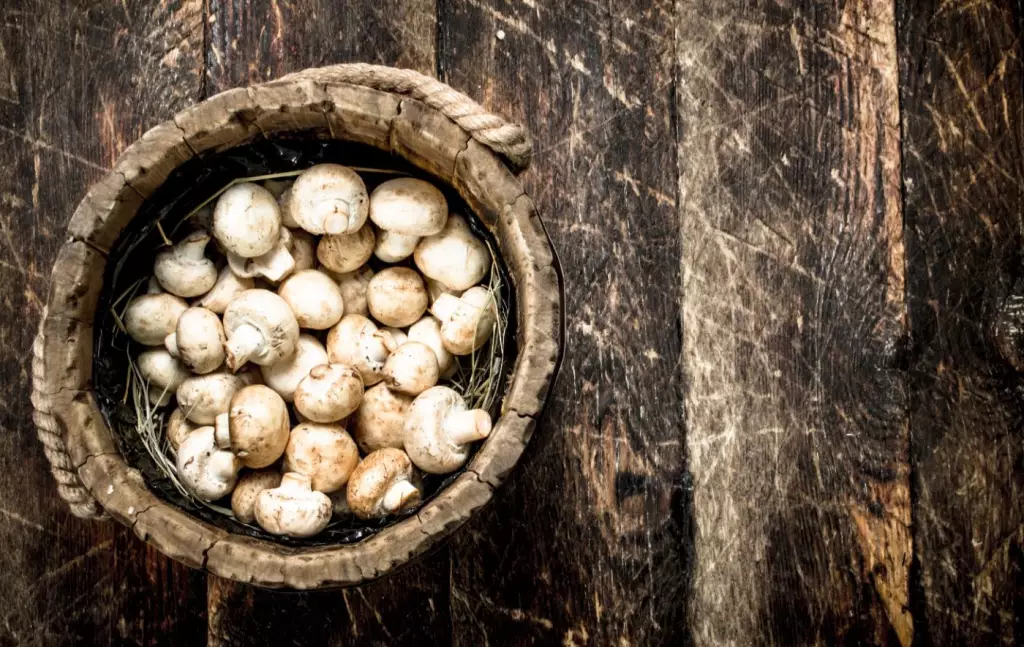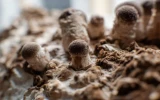Average Mushroom Yield Overview (Button, Shiitake, Oyster)
Button, shiitake, and oyster mushrooms each require different care, substrates, and growing conditions to achieve optimal yields. For example, to yield six pounds of oyster mushrooms, it is recommended to use about 2.5–5 lbs of grain or sawdust spawn for each 5-gallon bucket. In this article, we'll discover the potential mushroom yield for the three common types of mushrooms, and monotub, using various cultivation approaches.
The average yield of button mushrooms is 1 pound per bag. Shiitake mushrooms yield an average of 5 lbs per 5-gallon bucket, while oyster mushrooms yield 6 lbs using the same method. The three mushrooms yield 1.25 lbs per bag on average. A monotub yields 4 lbs. on average per bag.
To increase your mushroom yields, it's crucial to select high-performing strains and time your harvest correctly. Let's find out more about the expected yields for button, shiitake, and oyster mushrooms, as well as monotub grown in bags, 5-gallon buckets, square meters, acres, and hectares.
Summary
- Choose high-performing mushroom strains if you want to reach optimal yield results.
- It's important to harvest mushrooms at the right time to maximize production.
- You can always adjust your growing methods to suit your specific type of mushroom and growing environment.
- Mushroom cultivation is a continuous learning process, and you can always improve your yield by refining your techniques, closely monitoring your growing conditions, and learning from your experiences.

On this page:
Average Yield of Button, Shiitake, Oyster, and Monotub
Each type of mushroom mentioned here requires different care, substrates, and growing conditions to achieve optimal yields. To know how much yield to expect with a different location or size of growing area, it helps if you understand their specifics. It's important to choose the one that best suits your resources and goals.
| Mushroom Type | Yield per Bag | Yield per 5-Gallon Bucket | Yield per Square Meter | Yield per Acre | Yield per Hectare |
|---|---|---|---|---|---|
| Button | 0.5-1.5 lbs | 2-3 lbs | 5-10 lbs | 1,500-2,000 lbs | 6,000-8,000 kg |
| Shiitake | 1-1.5 lbs | 4-6 lbs | 10-15 lbs | 2,500-3,000 lbs | 10,000-12,000 kg |
| Oyster | 1-2 lbs | 4-8 lbs | 10-20 lbs | 2,500-3,500 lbs | 10,000-14,000 kg |
| Monotub | 3-5 lbs | 12-20 lbs | 30-50 lbs | 7,500-10,000 lbs | 30,000-40,000 kg |
Button mushroom yields 1 lb per bag
With proper care, you can expect yields of about 5–10 lbs per square meter. You can grow button mushrooms in composted horse manure or other compost substrates.
| Button Mushroom | Per Bag | Per 5-Gallon Bucket | Per Square Meter | Per Acre | Per Hectare |
|---|---|---|---|---|---|
| Average Yield | 1 lb | 2.5 lbs | 7.5 lbs | 1,750 lbs | 7,000 kg |
Button mushrooms, also known as white mushrooms or Agaricus bisporus, are the most common type of mushroom cultivated for commercial purposes. A great option for beginners, they are fairly easy to grow and maintain.
Shiitake mushroom yields 5 lbs per 5-gallon bucket
Shiitake mushrooms can take up to six months to fully colonize and produce 1-2 pounds of mushrooms per 5-gallon bucket or block. Shiitake mushrooms can provide yields ranging from 10–15 lbs per square meter, making them ideal for those seeking long-term cultivation.
| Shiitake Mushroom | Per Bag | Per 5-Gallon Bucket | Per Square Meter | Per Acre | Per Hectare |
|---|---|---|---|---|---|
| Average Yield | 1.25 lbs | 5 lbs | 12.5 lbs | 2,750 lbs | 11,000 kg |
Shiitake mushrooms (Lentinula edodes) are another popular type of mushroom loved for their rich, umami flavor. Typically grown on hardwood logs or sawdust substrates, they require a specific environment and care.
Oyster mushroom yields 15 lbs per square meter
Oyster mushrooms grow well in 5-gallon buckets, producing around 100% biological efficiency. This means that 1 lb of fresh mushrooms is produced per pound of dry substrate, over multiple flushes. For each 5-gallon bucket, it is recommended to use about 2.5–5 lbs (1–2.3 kg) of grain or sawdust spawn.
For oyster mushrooms, using a 5-gallon bucket is fairly popular. If you're using a similar setup, remember to use spawn at a rate of five to ten percent for each 5-gallon bucket.
| Oyster Mushroom | Per Bag | Per 5-Gallon Bucket | Per Square Meter | Per Acre | Per Hectare |
|---|---|---|---|---|---|
| Average Yield | 1.5 lbs | 6 lbs | 15 lbs | 3,000 lbs | 12,000 kg |
Oyster mushrooms (Pleurotus spp.) are known for their versatility in growing conditions and substrates, such as straw, wood chips, sawdust, and sugarcane mulch. This makes oyster mushrooms an excellent choice for indoor and outdoor cultivation, as well as a variety of scales.
Monotub yields 4 lbs per bag
Experienced growers can expect between 1–4 flushes of mushrooms, with yields varying by individual containers and techniques. Yields from growing in monotubs can vary greatly depending on the specific strain, quantity of substrate, and environmental factors.
A monotub is not a type of mushroom but a cultivation method used primarily for growing Psilocybe cubensis mushrooms. The monotub method involves using large plastic containers and a substrate such as coir or vermiculite.
| Monotub | Per Bag | Per 5-Gallon Bucket | Per Square Meter | Per Acre | Per Hectare |
|---|---|---|---|---|---|
| Average Yield | 4 lbs | 16 lbs | 40 lbs | 8,750 lbs | 35,000 kg |
Yield Measurements of Button, Shiitake, Oyster, and Monotub
If you want to maximize your growing output, it helps to understand the potential yield of different mushroom varieties. In this section, we'll explore the yield measurements for button, shiitake, and oyster mushrooms, and monotub, measured through various methods such as per bag, per 5-gallon bucket, per square meter, per acre, and per hectare.
-
Per bag: When growing mushrooms in bags, you'll find different varieties yield different amounts of fruiting bodies. Button mushrooms typically yield around 1 pound per bag, while shiitake mushrooms can produce a yield of 0.5 pounds to 1 pound per bag. Oyster mushrooms, on the other hand, can yield as much as 3 pounds per 5-pound supplemented sawdust fruiting block.
-
Per 5-gallon bucket: Utilizing a 5-gallon bucket for growing mushrooms is a popular method for hobbyists and small-scale growers. You can generally achieve different yields for various types of mushrooms. For example, blue oyster mushrooms can yield up to 3 pounds from a 5-pound supplemented sawdust fruiting block.
When using 5-gallon buckets, you can achieve higher yields by using spawn at a rate ranging from five to ten percent. Meanwhile, log-grown shiitakes can result in average yields of 20–50 lbs per week when grown on 500-1000 logs from June to October.
-
Per square meter: As you scale your mushroom-growing operation, measuring your yield per square meter becomes more relevant. By maximizing the area's potential, you can increase the overall output of your mushrooms.
-
Per acre: Yield measurements per acre are most important for large-scale commercial mushroom growers. Due to the varied cultivation methods typically used for each type of mushroom, the data on yield per acre may differ across different varieties.
-
Per hectare: When considering even larger scales, per-hectare yield measurements can help gauge the overall efficiency and productivity of a mushroom farm.

Factors Affecting the Yield of Mushrooms
The yields of different mushroom varieties, including button, shiitake, oyster, and monotub, are influenced by the following factors:
-
Strain selection: The first factor to consider is choosing a high-performing strain. Some strains will produce better yields than others, depending on their genetic makeup and adaptability to certain growing conditions. So, be sure to select the strains that best suit your specific growing environment and goals.
-
Substrate and supplementation: The type and quality of the substrate used can have a significant impact on mushroom yield. Additionally, supplementing the substrate with the right nutrients can further enhance the growth and yield of your mushrooms. It is important to ensure that you provide an appropriate substrate for the specific type of mushroom you are cultivating.
-
Temperature and humidity: Each mushroom variety has an optimal temperature range within which it will grow and fruit. Ensuring that your growing environment maintains the appropriate temperature for your chosen mushroom species is crucial. Similarly, managing humidity levels helps promote proper mycelium growth and fruiting.
-
Cropping container: The container used for growing mushrooms can affect the yield as well. Factors like the size of the bag opening, which influences the amount of substrate exposed to air, can impact your overall yield. Experimenting with different container types, like 5-gallon buckets or monotubs, will help you identify what works best for your specific mushroom variety.
-
Proper harvest timing: Timing your harvest correctly improves the yield and quality of your mushrooms. By monitoring your mushroom's growth closely and harvesting at the appropriate stage, you can maximize your yield and maintain the quality of the final product.
Optimizing Your Mushroom Production
Let's now discuss some key pointers to help you maximize the yield of button, shiitake, and oyster mushrooms, and monotub.
A high-performing strain delivers good yields under optimal conditions. So, it's crucial to invest some time in choosing the right strain for your setup.
It's also important to understand the biological efficiency (BE) of each variety, which is a measure of the yield of mushrooms produced per unit of substrate used in the cultivation process.

The biological efficiency can vary depending on the specific growing conditions, substrate used, and other factors. Here's a quick look at the typical BE for each mushroom type:
-
Button mushrooms: 50-60% BE, for every kilogram of substrate used, they produce around 500-600 grams of mushrooms
-
Shiitake mushrooms: 30-50% BE, for every kilogram of substrate used, they produce around 300-500 grams of mushrooms
-
Oyster mushrooms: 50-70% BE, for every kilogram of substrate used, they produce around 500-700 grams of mushrooms
Once you've chosen a suitable strain, it's time to focus on your growing conditions. The key factors to keep in mind are maintaining an appropriate temperature, humidity, and air circulation. This can vary depending on the specific variety you are growing.
To maximize mushroom yield, allow your mushrooms to reach the right growth stage before harvesting. Ensure that the cap is just starting to curl upward but hasn't fully expanded yet. If you wait too long, the mushroom will start to lose nutrients and mass, resulting in a lower yield.



